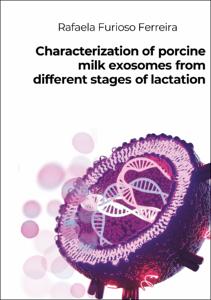Furioso Ferreira, Rafaela: Characterization of porcine milk exosomes from different stages of lactation. - Bonn, 2023. - Dissertation, Rheinische Friedrich-Wilhelms-Universität Bonn, Sveučilište u Zagrebu.
Online-Ausgabe in bonndoc: https://nbn-resolving.org/urn:nbn:de:hbz:5-70066
Online-Ausgabe in bonndoc: https://nbn-resolving.org/urn:nbn:de:hbz:5-70066
@phdthesis{handle:20.500.11811/10832,
urn: https://nbn-resolving.org/urn:nbn:de:hbz:5-70066,
author = {{Rafaela Furioso Ferreira}},
title = {Characterization of porcine milk exosomes from different stages of lactation},
school = {{Rheinische Friedrich-Wilhelms-Universität Bonn} and {Sveučilište u Zagrebu}},
year = 2023,
month = may,
note = {Exosomes are membranous vesicles considered major players in cell-cell communication. Milk provides adequate nutrition, transfers immunity, and promotes neonate development, and milk exosomes are suggested to have a key role in these processes. The ratio of dietary omega-6:omega-3 (ω-6:ω-3) polyunsaturated fatty acids (PUFA) affects health and inflammation, and can induce changes in milk fatty acid composition, but no reports have included the proteome and the lipidome of the exosomal fraction. Milk samples were obtained on days 0, 7, and 14 after parturition from sows receiving either a standard diet (ω-6:ω-3 = 13:1), or a test diet enriched in ω-3 (ω-6:ω-3 = 4:1), and exosomes were isolated using ultracentrifugation coupled with size exclusion chromatography, and characterized by nanoparticle tracking analysis, transmission electron microscopy, and assessment of exosomal markers via Western blotting. The proteome was explored using a Tandem Mass Tag-based high-resolution quantitative approach and the lipidome was assessed using untargeted metabolomics by a liquid chromatography-quadrupole time-of-flight mass spectrometry approach. A total of 319 proteins in each timepoint were identified in milk exosomes. Exosomes from colostrum presented 162 differentially abundant proteins (DAP) as compared to exosomes from milk on day 7, and 170 DAP from milk on day 14. The DAP revealed to be related to biological functions such as uptake of metabolites, regulation of homeostasis, and cellular development. A total of 947 lipids from sixteen subclasses were identified in both colostrum and milk exosomes. When compared to colostrum exosomes, we identified 734 differentially abundant lipids (DAL) in milk exosomes on day 7 and 779 DAL on day 14. Dietary treatments exerted an effect on the milk exosome proteome but not on their lipidome. Results unveil a distinct proteomic and lipidomic profile in porcine milk exosomes in different stages of lactation, with implications for their functional biology, and are relevant for potential strategies using milk exosomes as vehicles for drug or additive delivery.},
url = {https://hdl.handle.net/20.500.11811/10832}
}
urn: https://nbn-resolving.org/urn:nbn:de:hbz:5-70066,
author = {{Rafaela Furioso Ferreira}},
title = {Characterization of porcine milk exosomes from different stages of lactation},
school = {{Rheinische Friedrich-Wilhelms-Universität Bonn} and {Sveučilište u Zagrebu}},
year = 2023,
month = may,
note = {Exosomes are membranous vesicles considered major players in cell-cell communication. Milk provides adequate nutrition, transfers immunity, and promotes neonate development, and milk exosomes are suggested to have a key role in these processes. The ratio of dietary omega-6:omega-3 (ω-6:ω-3) polyunsaturated fatty acids (PUFA) affects health and inflammation, and can induce changes in milk fatty acid composition, but no reports have included the proteome and the lipidome of the exosomal fraction. Milk samples were obtained on days 0, 7, and 14 after parturition from sows receiving either a standard diet (ω-6:ω-3 = 13:1), or a test diet enriched in ω-3 (ω-6:ω-3 = 4:1), and exosomes were isolated using ultracentrifugation coupled with size exclusion chromatography, and characterized by nanoparticle tracking analysis, transmission electron microscopy, and assessment of exosomal markers via Western blotting. The proteome was explored using a Tandem Mass Tag-based high-resolution quantitative approach and the lipidome was assessed using untargeted metabolomics by a liquid chromatography-quadrupole time-of-flight mass spectrometry approach. A total of 319 proteins in each timepoint were identified in milk exosomes. Exosomes from colostrum presented 162 differentially abundant proteins (DAP) as compared to exosomes from milk on day 7, and 170 DAP from milk on day 14. The DAP revealed to be related to biological functions such as uptake of metabolites, regulation of homeostasis, and cellular development. A total of 947 lipids from sixteen subclasses were identified in both colostrum and milk exosomes. When compared to colostrum exosomes, we identified 734 differentially abundant lipids (DAL) in milk exosomes on day 7 and 779 DAL on day 14. Dietary treatments exerted an effect on the milk exosome proteome but not on their lipidome. Results unveil a distinct proteomic and lipidomic profile in porcine milk exosomes in different stages of lactation, with implications for their functional biology, and are relevant for potential strategies using milk exosomes as vehicles for drug or additive delivery.},
url = {https://hdl.handle.net/20.500.11811/10832}
}






